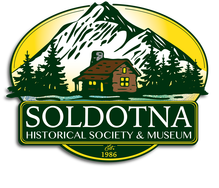Soldotna, Alaska - First bridge over the Kenai River
Soldotna Historical Society & Museum, Inc.
In 1960, students who had been attending the Slikok Elementary School (the last territorial school, built by local volunteers and opened in 1958) were bused to the new Soldotna Elementary. The Slikok School became the Slikok Valley Community Club until it dissolved, when the school was turned into a museum. Damon Hall was built onto the old Slikok School in 1972 and the two building were separately moved from Poppy Road to the current location of the Homestead Museum off Centennial Park Road.
The museum concept and preservation of homesteading heritage was started in 1962 by Mae Ciechanski and others, without whose generosity and drive there would be no Soldotna Historical Society & Museum, Inc. The Soldotna Historical Society & Museum was officially incorporated on Dec. 24, 1986 with seven incorporates and five board directors. As of 2018, the Society has seven board directors.
The museum concept and preservation of homesteading heritage was started in 1962 by Mae Ciechanski and others, without whose generosity and drive there would be no Soldotna Historical Society & Museum, Inc. The Soldotna Historical Society & Museum was officially incorporated on Dec. 24, 1986 with seven incorporates and five board directors. As of 2018, the Society has seven board directors.
Vision & Mission
Vision:
Presenting & Preserving the Past in Perpetuity:
“Presenting” includes all aspects of display, education, interpretation and increasing o public awareness in an authentic yet, user friendly way.
“preserving” includes security, protection (from elements, deterioration, thieves, and loss), documenting and protecting authenticity, cataloging and providing curator-ship for all records, documents, collectibles and collections, buildings, and artifacts.
“Past” refers to oral and written histories and objects of history or antiquity, including buildings and collectibles. It also includes the living past through the eyes of homesteaders and period actors.
The phrase “in perpetuity” means for a period of time without end, or forever and is used to give tenure and strength to the organization in honor of the perseverance of the original homesteaders.
Mission:
Presenting and preserving the past in perpetuity by: acquiring, presenting, and preserving buildings, histories, and collectibles; by expanding education through display, interpretation and increased awareness; and by curator-ship of acquisitions and properties of the Society.
Presenting & Preserving the Past in Perpetuity:
“Presenting” includes all aspects of display, education, interpretation and increasing o public awareness in an authentic yet, user friendly way.
“preserving” includes security, protection (from elements, deterioration, thieves, and loss), documenting and protecting authenticity, cataloging and providing curator-ship for all records, documents, collectibles and collections, buildings, and artifacts.
“Past” refers to oral and written histories and objects of history or antiquity, including buildings and collectibles. It also includes the living past through the eyes of homesteaders and period actors.
The phrase “in perpetuity” means for a period of time without end, or forever and is used to give tenure and strength to the organization in honor of the perseverance of the original homesteaders.
Mission:
Presenting and preserving the past in perpetuity by: acquiring, presenting, and preserving buildings, histories, and collectibles; by expanding education through display, interpretation and increased awareness; and by curator-ship of acquisitions and properties of the Society.

